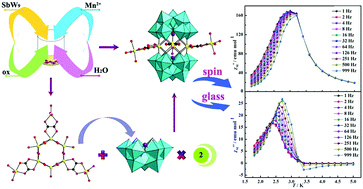Coexistence of long-range ferromagnetic ordering and spin-glass behavior observed in the first inorganic–organic hybrid 1-D oxalate-bridging nona-MnII sandwiched tungstoantimonate chain†
Abstract
A neoteric 1-D sinusoidal tungstoantimonate (TA) Na2H4{[Mn(H2O)3]3[Mn(H2O)2]2[Mn(H2O)][Mn(C2O4)]3[B-α-SbW9O33]2}·31H2O (1) was synthesized from the reaction of Na9[B-α-SbW9O33]·19.5H2O with MnCl2·4H2O with the assistance of oxalic acid and structurally characterized by elemental analysis, IR spectroscopy, single-crystal X-ray diffraction, powder X-ray diffraction and thermal analyses. In 1, an unprecedented oxalate-bridging nona-MnII {[Mn(H2O)3]3[Mn(H2O)2]2[Mn(H2O)][Mn(C2O4)]3}12+ cluster is clamped by two trivacant Keggin [B-α-SbW9O33]9− fragments forming a unique nona-MnII-encapsulated sandwich-type species. In the sandwich belt, the internal hexa-MnII {[Mn(H2O)2]2[Mn(H2O)][Mn(C2O4)]3}6+ ring is alternately concatenated with three [Mn(H2O)3]2+ ions situated at three vertices of an equicrural triangle through oxalate linkers, completing an approximately coplanar nona-MnII core. More interestingly, adjacent nona-MnII-sandwiched TA units are interconnected by double MnII–C2O4 linkages, giving rise to the first inorganic–organic hybrid 1-D chain high-nuclear Mn-sandwiched TA. Furthermore, the zero-field-cooling/field-cooled magnetization and alternating current magnetic susceptibility measurements reveal the occurrence of long-range ferromagnetic ordering and spin-glass behavior in 1, which are further consolidated by the fitting of the Arrhenius law and the conventional critical scaling law of spin dynamics.



 Please wait while we load your content...
Please wait while we load your content...